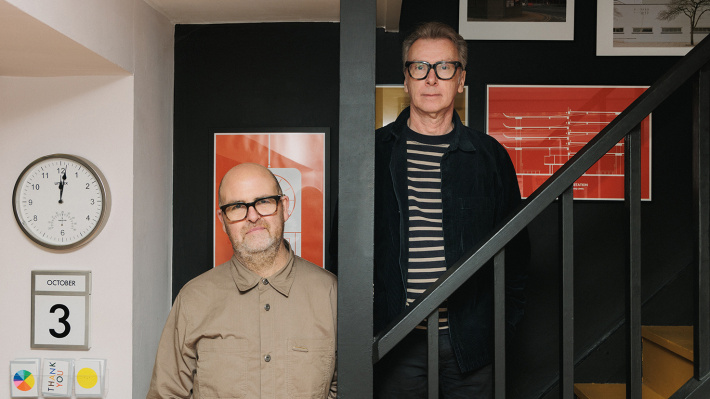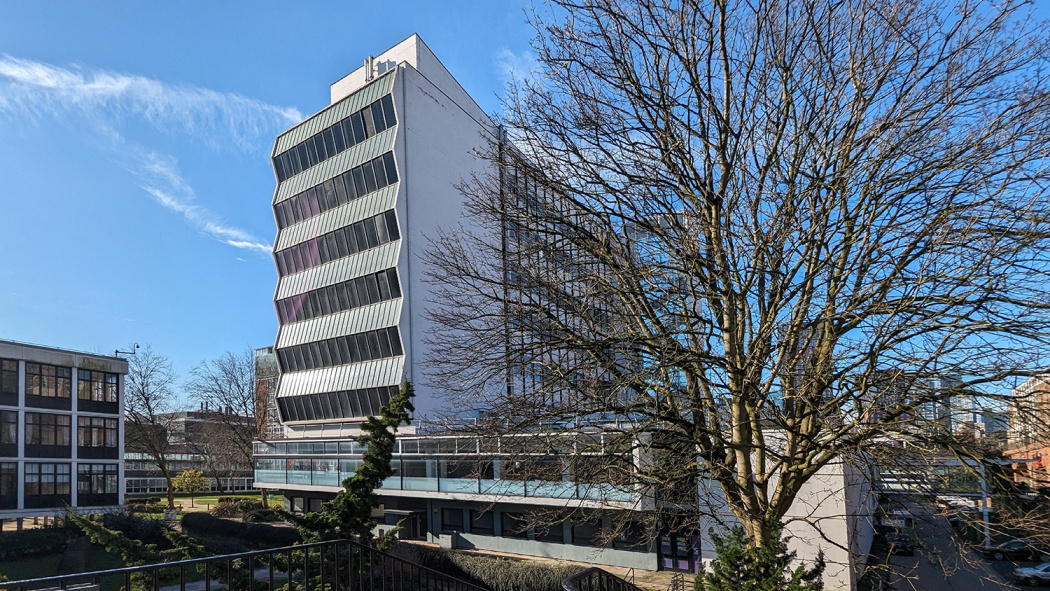The modernists
Championing an appreciation of twentieth-century architecture

Words: Vitsœ
Photography: Jordan Bunker and The Modernist Society
Manchester, north-west England, can claim a disproportionate number of cultural, scientific and social achievements, worthy of many capital-cities around the world. Equally impressive is its rich and diverse architectural landscape, spanning multiple eras and currently undergoing yet another major regeneration. The result is large pockets of Victorian warehouses sitting cheek-by-jowl with sleek freshly-constructed glass skyscrapers. Much of the city centre is still formed of beautiful red-brick mills and grand municipal halls, recalling past industrial glories. Wandering the backstreets and alleyways, you could be forgiven for believing you’ve been transported to Lower Manhattan, a fact not lost on production crews who frequently film here as stand-in for New York.
For Jack Hale and Eddy Rhead of ‘The Modernist Society’ however, it is the city’s post-war architecture – characterised by functional steel, glass and brutalist concrete buildings – that fuels their obsession.
As an independent non-profit organisation, The Modernist Society is dedicated to celebrating and promoting 20th-century architectural design and its philosophies. It is all at once: a magazine, publisher, online and bricks & mortar shop, gallery, tour operator, app developer and occasional preservationist – ultimately though, it is a community. Located in one of the oldest buildings in Manchester, Jack and Eddy are a modest, down-to-earth pair – their sharp sense-of-humour matching their encyclopedic knowledge. The society’s HQ is a busy, bustling rabbit-warren, set over a three-storey former weaver’s cottage, filled with laughter and chatter from the comings-and-goings of volunteers, collaborators, editors, graphic designers and visitors to the ground-floor shop.

The genesis of what began as ‘The Manchester Modernist Society’ started in the late 2000’s as a notion “always sort of floating in the back of my mind” says Jack, who felt “there wasn’t enough architectural stuff happening (in Manchester), no design museum, architecture centre, events or anything that really talked about architecture. I was having a chat with a friend, [co-founder] Maureen Ward, about an art project to do with telephone boxes. There were only four classic red K6 boxes left in Manchester at the time, which led us to realise we were interested in the 20th-century part of the city – all of this 40s, 50s, 60s, 70s design that no one seems to care about. These four neglected little structures represented the wider mid-century architecture of Manchester. We felt that they symbolised the neglect and lack of interest in 60s office blocks – so that became the project. We decided to call ourselves ‘The Manchester Modern Society’ almost as a joke, but shortly after we thought, ‘let's make it into an actual organisation’. But you always need three people for a constituted organisation…”
Which is when Eddy joined the party; “I kind of ran the Twentieth Century Society north-west group at the time. It's a campaign group, a lobbying group. It was a time when we were losing lots of mid-century buildings in Manchester, and I was fighting against developers and local councils. I found it quite draining. Just as I decided I was done, somebody said, ‘I've seen these modernist people on Facebook…’ and it appealed to me because it was a positive thing, a creative thing. Jack and Maureen came from an arts background, and I came from an architectural-history background. I knew the dates and the names and all that. I think they needed to add that to it”.

From there the project gathered pace: “The first event we did was a picnic”, continues Jack “we just posted online ‘we’re going to have a picnic in St Peter’s square’, Maureen made some building-shaped biscuits, and about 35 people turned up. We realised these were our people! Then we started to do an activity every month. We borrowed some films from the North-west Film Archive and showed those. And a bit later we got involved with students at the Art School, and printed a tiny little booklet: an A-to-Z of Manchester modernism.”
That understated first publication eventually led to ‘the modernist’ magazine, a lovingly-produced square-format quarterly – now with over 50 issues and almost fifteen years in print – containing niche, lesser-known architectural insights ranging from waste-bin design to motorway service-stations and sheds. It was conceived by the trio (Maureen moved on after five years) as fiercely independent with no advertising to be found within, and relying entirely on the generosity and enthusiasm of talented writers, photographers and experts. Eddy explains: “There’s an honesty to it, and people respect that. We're a non-profit, we couldn't do it without people’s goodwill, giving their time and their effort. The magazine makes no sense financially – it only works because people contribute for free, and people seem to be willing to do that”.

It was through the magazine’s success that Jack and Eddy truly discovered that they weren’t alone in their passions when, in the early days, Eddy realised: “We've got an order from Australia! Who are these people who are into the really weird things that we're into?” That was really important to us. There are some universal truths about modernism that people can connect with, people from very different cultures and backgrounds. We've got a die-hard fan in South Korea. A big-shot lawyer in Chicago buys everything. It's quite humbling.” He concludes, “People found that there are others who have the same nerdy interests as them. Previously, they thought, ‘I’m alone in the world’, and then they opened our magazine. And, oh! It's an article about bins!” The magazine’s popularity eventually led to an unlikely connection. Ex-The Smiths guitarist, Johnny Marr, was sent a copy by a fan who knew he shared a common interest. Jack remembers: “I came back to the office one lunchtime and he was stood outside!” Marr went on to join writer and broadcaster Jonathan Meades as an official patron of the society.

This all reflects a growing public appreciation for modernism over recent years (its buildings previously dismissed by so many as eyesores). The UK’s first brutalist architecture museum has just been announced for London, and The Modernist Society itself has outgrown Manchester alone, hence its simplified name. It has volunteer-run ‘branches’ in other British cities such as Birmingham, Liverpool, Leeds, Swansea, Sheffield, Glasgow and, as of this year, Bristol.“The phenomenon over the last ten years of Instagrammable brutalist buildings is immense,” notes Jack, while Eddy adds: “We can’t claim credit for it, but we have to take some. It’s a global phenomenon, and we're part of it. We’re an organisation who celebrates these buildings, but you have to contextualise it: why they were built, the reason they were built.”
Which reveals the deeper philosophy behind modernism that appeals so strongly to the duo: “It's the optimism, the pioneers who pushed modernism forward – and Dieter Rams is probably the prime example of this – they wanted to improve people's lives, be it through architecture, through design, through good planning, or through ideology.” Eddy discloses, “That’s what we like about that period – especially in Britain – that post-war optimism, setting up the welfare state and lots of state-driven projects. Getting [British industrial designer] David Mellor to design a bin that would be in the street, you just don’t get that now, getting a top-class designer to do something which had a very mundane function, and which is completely accessible to everybody. It’s not elitist, we like the mundane, and the way modernism has infiltrated people’s lives on a very general level.”

There’s a decidedly educational element to what Jack and Eddy do, not least through their book-publishing arm: “Of course there is, but in a fun, accessible way”, clarifies Eddy. As a publishing house, ‘the modernist’ now has over 40 titles under its belt. Recent examples include studies on Midlands typography, European cars, Birmingham’s Spaghetti Junction interchange, functionalist Welsh cabins, and a latest book on Scottish modernism. It was the 2020 pandemic that first turned them into serious publishers. Eddy explains: “Lockdown happened and our core activities stopped. It kept us busy, because we could do everything from home, and digital printing meant you could do quick, short runs.” Much like their magazine, book-production relies entirely on their network of supportive partners. Eddy, furthers: ”Going back to goodwill – there’s an attitude in Manchester: ‘nobody else is going to do it, so we're going to do it ourselves’. If people see you're doing it for all the right reasons, they will come along with you in Manchester.”
Their achievements in publishing have led to spin-off events including an annual ‘Modernist Book Fair’ organised for like-minded publishers and hosted at Vitsœ’s Marylebone shop in London. And the society’s latest effort to enlighten the masses has seen them take the leap from analogue to digital: ‘the modernist’ app allows users to take a walking tour of 20th-century architecture in numerous UK cities for free, guided via a map on their phone and – like the magazine – completely advert-free.

Overall, it could be argued that there’s an element of nostalgia to Jack and Eddy’s devotion to things past, but for them it’s very much a case of looking forward, not backward. Jack concludes: “Much of it has become the norm. Not long ago, the thought of living in a tower block was abhorrent to many, because they only associated it with decaying council blocks – but now it’s completely normal. There are things that environmentally need to change – maybe we should use wood instead of concrete – but it can still be forward-thinking, modern and high-tech.”
–––
The Modernist Book Fair will take place on 17 and 18 October at Vitsœ’s London shop – free entry:
• Friday 17, 10:00-20:30 (extended opening):
Magazine launch and drinks reception from 18:30 – ‘the modernist’ issue 55
• Saturday 18, 10:00-18:00
Vitsœ
21 Marylebone Lane
London W1U 2NG



